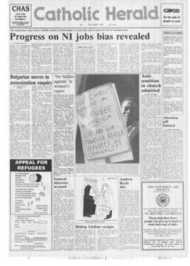Page 7, 26th April 1991
Page 7

Report an error
Noticed an error on this page?If you've noticed an error in this article please click here to report it.
Tags
Share
Related articles
Confusion Of The Two Shrines Of Alsingham
Witnessing A New Dawn Of The Spirit In Walsingham
The Holy Land Of Walsingham Is Being Noticed
Holy House In North Norfolk Countryside
Campaign Is Launched To Save Medieval Chapel
In the footsteps of the faithful
FOOTSORE and weary, medieval pilgrims to the shrine of Our Lady at Walsingham in Norfolk would have stopped on the last leg of their journey at the tiny chapel of St Catherine before making their final assault on the town. And there they left their shoes to walk barefoot, just as Moses was said to have done at Mount Sinai where St Catherine herself was buried.
Today's pilgrims, although less inclined to part with their shoes, follow in a tradition of devotion to the Virgin at Walsingham stretching back at least as far as the eleventh century. The site of the shrine may have changed (the "Holy House" representing the home in Nazareth where the angel appeared to Mary with the news that she was to become the mother of God was destroyed by Henry VIII), but the atmosphere of Christian worship remains. permission of Pope Leo XIII in 1897.
The sanctuary is now at the Slipper Chapel, the church of St Catherine so familiar to the pilgrims of Chaucer's day. Built in the later fourteenth century, . the present church is a successor to earlier chapels on the same site, and was restored with the For the next three decades the national shrine was to be at King's Lynn, where the Holy House of the Virgin was rebuilt. The public popularity of pilgrimages to Walsingham increased year by year, and the Slipper Chapel emerged as an obvious centre of devotions.
In August 1934, Cardinal Francis Bourne and Bishop Lawrence Youens led 10,000 people in pilgrimage to the Slipper Chapel for a ceremony marking the transferring of the national shrine to the site. A priest-custodian, Fr Bruno Scott James was appointed to look after the needs of the chapel. And a community of Franciscans did what they could to help from the village.
From that time on the pilgrimages grew ever larger, one of the most notable following just a few years later in 1938 on the 400th anniversary of the destruction of the preReformation shrine.
During the second World War members of the armed forces organised their own pilgrimages to the sanctuary, and in May 1945 the United States military arranged the first mass to be said in the ruins of the Augustinian priory which had administered the shrine of Our Lady until its destruction in the Reformation.
Once the war was over, the student pilgrimages which have become so much a feature of Walsingham life began with the help of the Union of Catholic Mothers, which has always had a special concern for the shrine. Carrying oak crosses, students from universities and colleges all over the country walk to the Slipper Chapel during Holy Week, where they follow the stations of the cross.
Since 1968 Marist fathers and Marist sisters have been responsible for the care of the shrine. The ever-growing interest in the sanctuary means that it is not possible to estimate with any accuracy the exact number of pilgrims who visit each year, but during the Holy Week season attendances top 250,000 people.
With such large numbers of pilgrims, open air facilities for mass were quickly added next to the Slipper Chapel. And in the style of the traditional flint-built Norfolk barn, a chapel of reconciliation was begun in the autumn of 1980, to be consecrated two years later by Bishop Alan Clark of East Anglia.
The new chapel's altar, made of Aberdeen granite and containing relics of the third century St Lawrence of Rome as well as those of St Thomas Becket and St Thomas More, doubles up as the focal point of the open air sanctuary at times when the building itself is overflowing with pilgrims.
Europe's highways were once filled with men and women travelling to the Christian shrines which abounded in the abbeys and churches of the Middle Ages. Walsingham aims to be the first step towards the rediscovery of the unity of the faithful of that time, a marker on the way to the continent's re-evangelisation so hoped for by Pope John Paul 11.
blog comments powered by Disqus











